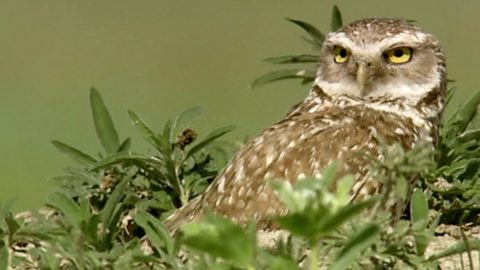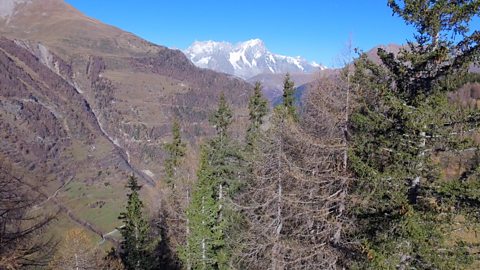Exploring the coniferous (taiga / boreal) forest biome.
The video
Finland in Northern Europe is the home of saunas and traditionally they are heated using wood from trees like these.
I am here in a forest in the Nuuksio National Park. It’s a coniferous forest, also known as a taiga or boreal forest.
It’s a terrestrial biome found in the temperate regions of the world at around 60 degrees north of the equator. Other countries like Japan, the USA, Canada, Russia and other parts of Scandinavia, also have coniferous biomes, like Finland.
It’s winter and the seasons tend to be similar to those in the UK: usually mild, short, warm summers and long, cold winters with adequate rainfall. This is known as a cool temperate climate.
The forest is dense and made up of spruce and pine trees, that grow closely together to try and create warmth and survive the cold conditions. Many of these trees are known as evergreens, as they don’t lose their leaves or needles in winter.
This is a Scots pine - you can tell from its distinctive bark, its height and its shape. The branches grow really close together and they’re quite short. In winter when it snows, it just slides off, because the branches are very flexible.
These spruce and pine trees also have very thick bark to cope with the cold weather and the thin, waxy needles reduce water loss. Their thick, straight, strong trunks make excellent plywood and lumber for building.
As you can see, not much light can penetrate through the canopy. On the forest floor only a few herbaceous plants can grow and survive the low light conditions - like mosses, lichen and ferns.
The understory floor is covered in pine needles. And while it makes it nice and spongy to walk on these pine needles don’t decay easily, which means that the soil is poor and acidic.
Lots of animals inhabit this coniferous forest, including the Siberian flying squirrel - and what a looker it is, with those big black eyes! It is a shy, nocturnal animal and it doesn’t hibernate for the whole winter. Instead, it will occasionally sleep for several days. It evolved to be able to glide swiftly through the trees due to a flap of skin between its front and rear legs. It can glide from tree to tree across distances of over 100 metres.
Reindeer are also built for this ecosystem with their antlers, thick warm coats and strong sense of smell, that helps them to find food hidden beneath the snow.
This is a wood lemming. It’s tiny and they only grow up to about 8 cm in length. They don’t hibernate over winter and they love to feed on vegetation buried under the snow. Wood lemmings don’t live very long - around one or two years - and that’s due to the harsh conditions here.
The amazing adaptations by plants and animals have enabled them to not only survive but flourish in this very special environment.
Right! Well, I’m off to go relax in the sauna. You know what they say: ‘When in Rome…’ or, should I say, ‘When in Finland…’
Video summary
Download/print a transcript of the video.
Wildlife presenter Ferne Corrigan visits Finland to learn how plants and animals adapt to living in coniferous forests.
Ferne is in the Nuuksio National Park in Finland, where she describes the location of coniferous or taiga forests around the world and what the climate is like.
Ferne focuses on the adaptations of Scot’s Pine and Spruce trees, and the effect pine needles have had on both plant life and the soil fertility.
Ferne also looks at the adaptations that the Siberian flying squirrel, reindeer and wood lemming have made to survive in this biome.
This clip is from the series Ecosystems and Biomes.
Teacher Notes
Key Stage 3
This could be used to introduce students to the coniferous forest biome, and how plants and animals have adapted to the conditions.
Students could create fact-files on how plants, animals and people have adapted to thrive in this biome.
Students could take a more in-depth look at the specific adaptations and behaviour of the Siberian flying squirrel.
Key Stage 4
This could be used to refresh students' knowledge of the coniferous forest biome, and how plants and animals have adapted to the conditions.
Students could create fact-files on how plants, animals and people have adapted to thrive in this biome.
Students could take a more in-depth look at the specific adaptations and behaviour of the Siberian flying squirrel.
This clip will be relevant for teaching Geography at KS3 and GCSE.
This topic appears in OCR, Edexcel, AQA, WJEC KS4/GCSE in England, CCEA GCSE in Northern Ireland, Progression Step 4/5/GCSE in Wales, and SQA National 4/5 in Scotland.
The wildlife and ecosystem of temperate savannas. video
Exploring grasslands to discover how plants, animals and people have adapted to the temperate savanna biome.

How animals have adapted to live in the Italian Alps. video
How plants, animals and people have adapted to an Alpine mountain region of Italy.

How animals have adapted to live in the polar biome. video
How animals have adapted to survive the freezing conditions of the polar ecosystem.
